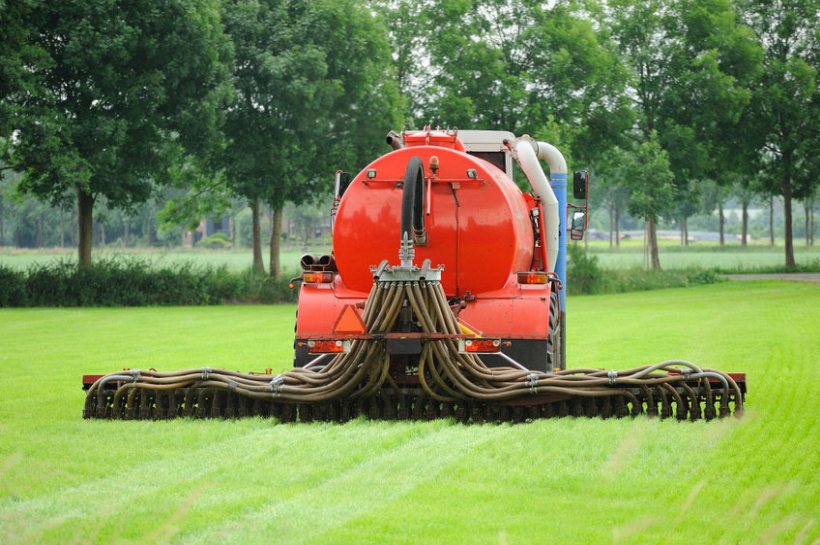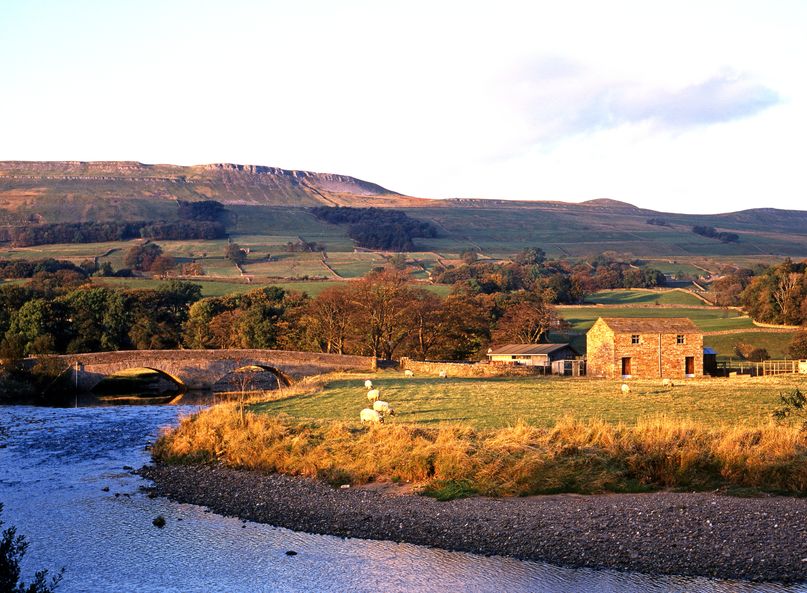
Dr William Stiles from the Institute of Biological, Environmental and Rural Sciences (IBERS) at Aberystwyth University, looks into the topic of Nitrate Vulnerable Zones (NVZs).
Modern methods of agricultural production rely on the addition of nutrients in the form of organic or manufactured fertiliser to sustain production levels. As a consequence, the use of fertiliser has increased significantly over the last 50 years.
Excessive fertiliser usage in this way can lead to the loss of nitrogen from agricultural land into ground or surface waters, which can present serious problems for water quality and aquatic ecosystems in catchments dominated by agricultural businesses.
?The EC Nitrates Directive (91/676/EEC) was created to reduce water pollution from agricultural sources. The Directive is delivered in Wales through the Nitrate Pollution Prevention (Wales) Regulations 2013, which aims to limit the potential detriment to aquatic systems from agricultural activity through the identification of susceptible areas known as Nitrate Vulnerable Zones (NVZs).
?
An NVZ is defined by Welsh Government as an area of land draining into ground or surface waters that are currently high in nitrate, or may become so if appropriate actions are not taken. Farms within an NVZ will be restricted with regard to how much nitrogen fertiliser can be applied to the land to limit the potential for loss to the wider environment.
Pollution or enrichment from excessive nutrient loads can severely impact aquatic ecosystems and can reduce the quality of drinking water through the effects of eutrophication. This is where enhanced growth of algae and higher forms of plant life can result in an undesirable disturbance to the balance between aquatic organisms in a water body and to the quality of the water concerned. Such factors can have considerable implications both economically and environmentally.
How are NVZs identified?
The nitrate pollution prevention regulations for Wales specify that both ground and surface water are considered polluted if they contain, or could contain, a concentration of nitrates greater than 50 mg per litre, or if natural freshwater lakes, other freshwater bodies, estuaries, coastal waters and marine waters are visibly eutrophic or have the potential to become so in the near future.
The directive also takes into account the physical and environmental characteristics of the water and land, as well as current scientific understanding of the behaviour of nitrogen compounds in the environment and the influence any preventative action may have.

Symptoms of eutrophication can be variable and may be expressed differently depending on the type of waters concerned (i.e. lake or estuary). Key indicators of eutrophication include changes to the aquatic plant community, algal blooms, low rates of dissolved oxygen in water (especially in deep lakes), problematic growths of certain plant species, especially filamentous algae (blanket weed), and the loss of sensitive fish species requiring high oxygen levels.
Where a body of water has a recorded high nitrogen level, which likely indicates eutrophication, several additional criteria have been chosen which relate to a broad range of aquatic processes to assess the level of effect. Measurements are taken for total phosphorus, dissolved oxygen, the abundance and composition of phytoplankton (blue-green algae), species composition, diversity and abundance of aquatic plants, and the abundance of a key aquatic invertebrate group (Chironomidae). When taken as a whole, these indicators provide a comprehensive evidence base of the impact from nutrient enrichment.
Across England and Wales over 250 lakes and reservoirs have been considered as potential candidates for designation. Of these, 38 lakes or reservoirs and 13 transitional and coastal waters have been recommended for designation. In Wales, 88 lakes were tested for water quality and 101 lakes surveyed for ecological data which would indicate eutrophication. As a result, in addition to the four existing NVZs in Wales (Bosherston Lakes, Hanmer Mere, Llangorse Lake and Llyn Coron), three additional lakes have been recommended for designation: Llyn Maelog (Anglesey), Llyn yr Wyth Eidion (Anglesey) Llyn Pencarreg (Carmarthenshire).
Factors to consider
To be compliant with NVZ legislation on farms within a designated zone, careful planning is required to ensure rates of nitrogen application are appropriate.
Current limits for nitrogen addition to the whole holding must not exceed 170 kg of nitrogen in livestock manure per hectare per year. In certain instances this can be increased to 250 kg of nitrogen in manure per hectare per year with the grassland derogation, providing the manure source is grazing livestock (cattle, sheep, deer, goats and horses) and more than 80% of the agricultural area applied for is grassland.
Certain factors need to be considered to effectively develop a fertilisation plan. These include calculating existing soil nitrogen contents available for crop (including grass) uptake during the growing season, the specific nitrogen requirements of that crop, the amount of nitrogen which will be available for crop uptake from organic manure addition and the amount of manufactured fertiliser required.
In addition, nitrogen application rates must be tailored to ensure the N-max limit for specific crops is not exceeded. Prior to application, it is necessary to establish the nitrogen content (both as a total and as a crop-available figure) in organic manures to avoid inadvertently exceeding limits. This can be achieved by direct sampling and analysis, or by using standard values. Typical values can be obtained from sources such as the Fertiliser Manual (RB209) or Manner-NPK software.
Restrictions also need to be observed for situations where nitrogen application would be unsuitable. Fertiliser must not be spread where fields are waterlogged, flooded, covered in snow, or have been frozen for more than 12 of the previous 24 hours. Manufactured nitrogen fertiliser should not be spread within two metres of surface water and organic manure should not be spread within 50 metres of a spring, well, or borehole, and not within 10 metres of surface water. Field characteristics should also be taken into consideration, where factors such as topography could lead to increased potential for runoff.
Additional management approaches
Nutrient pollution originates from point sources, such as inadequate slurry storage or sewage treatment facilities, or from diffuse sources, where it is more difficult to identify the exact origin of pollution, particularly at the catchment scale, as it results from factors such as water runoff from fields.
On-farm infrastructure, such as effective drainage systems to separate clean and dirty water, can significantly reduce the potential for point source pollution, as this may avoid unnecessary collection of rainwater, leading to reduced slurry storage potential and resulting in forced disposal of polluted material during wet weather conditions.
Tree planting and allowing undisturbed growth of other vegetation along the banks of rivers to create riparian buffer strips (vegetation barriers between river and field), may reduce some of the influence of diffuse pollution entering waters. Nitrogen can be removed by riparian buffers through plant uptake and utilisation, or through the process of denitrification where biologically available nitrate is converted by micro-organisms to gases such as nitrogen gas, nitric oxide or nitrogen dioxide (N2, NO or NO2). Riparian buffers have been shown to retain 30-99% of nitrate and 20-100% of phosphorus from runoff and shallow groundwater.
Vegetation buffer strips are also beneficial in terms of riverbank stability, improved biodiversity, and can be managed for the purposes of fuel, feed or fibre production. In general, vegetation, particularly trees, are accepted to be efficient in the removal of nitrates, however the rates of removal via this approach are accepted to be highly variable. This disparity can likely be attributed to location specific environmental factors, such as the difference between soil type (organic or mineral), or factors which may influence rates of denitrification. In addition, the size (width) of a buffer strip is likely to play a key role in its ultimate success in mitigating diffuse pollution.
What are the benefits?
The loss of nutrients into the water environment is highly damaging from an ecological perspective and can significantly impact the health and function of aquatic ecosystems.
Any reduction in the harmful effects of nutrient pollution on UK water quality therefore would be of great benefit to the biodiversity levels and function of these natural systems.
Alongside the environmental impact, the loss of nutrients to the environment also represents an economic loss to the farmer. Fertiliser is a valuable resource and wastage will have direct financial implications, particularly where additional purchases of fertiliser will be required. Through increasing the precision of applications of nitrogen, particularly with regard to better accounting for the nutrient value in applied organic fertilisers, it is possible to lower overall fertiliser costs for individual farm businesses, whilst simultaneously limiting environmental impact.
Nutrient pollution may adversely affect the quality of UK water, which could result in higher economic investment necessary for treatment procedures to ensure safe and clean drinking water. Water quality is of significant importance for numerous industries including recreation and tourism, fisheries and agriculture, horticulture and food processing and is thus a high priority. High levels of nutrients in water courses may also negatively impact infrastructure associated with water management (i.e. weirs, sluices) where the increased growth of vegetation from nutrient enrichment could affect function.
Summary
NVZs offer a framework and policy which encourages farmers to consider the size, scale and consequences of fertiliser usage, both in the context of environmental impact and also economic efficiency. When undertaken appropriately, this can serve to increase the precision of agricultural business practice, which is beneficial for both the farmer and the wider environment.
